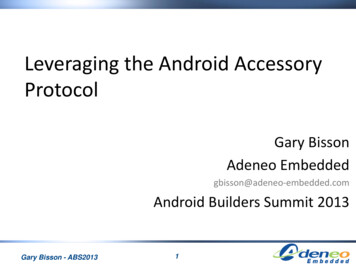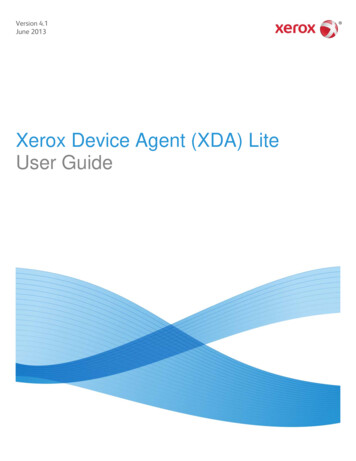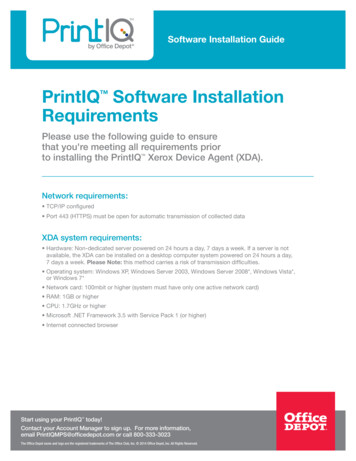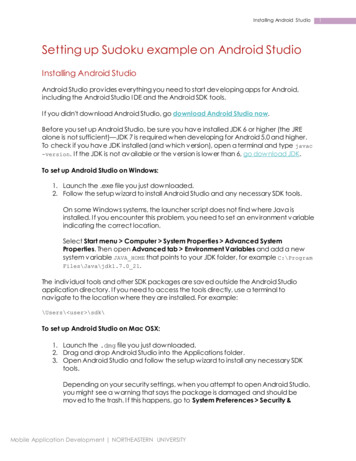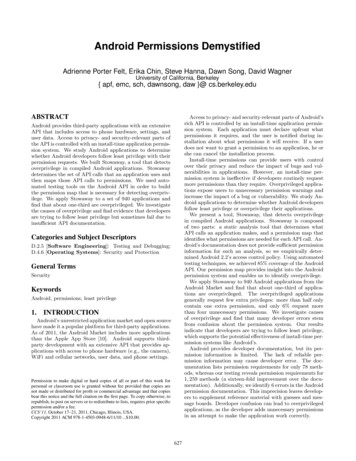
Transcription
XDA Developers’ AndroidHacker’sToolkit
XDA Developers’ AndroidHacker’s ToolkitTHE COMPLETE GUIDE TO ROOTING, ROMSAND THEMINGJason Tyler with Will VerduzcoThis work is a co-publication between XDA Developersand John Wiley & Sons, Ltd.A John Wiley and Sons, Ltd, Publication
This edition first published 2012 2012 John Wiley and Sons, Ltd.Registered officeJohn Wiley & Sons Ltd, The Atrium, Southern Gate, Chichester, West Sussex,PO19 8SQ, United KingdomFor details of our global editorial offices, for customer services and forinformation about how to apply for permission to reuse the copyright materialin this book please see our website at www.wiley.com.The right of the author to be identified as the author of this work has beenasserted in accordance with the Copyright, Designs and Patents Act 1988.All rights reserved. No part of this publication may be reproduced, stored in aretrieval system, or transmitted, in any form or by any means, electronic,mechanical, photocopying, recording or otherwise, except as permitted by theUK Copyright, Designs and Patents Act 1988, without the prior permission ofthe publisher.Wiley also publishes its books in a variety of electronic formats. Some contentthat appears in print may not be available in electronic books.Designations used by companies to distinguish their products are often claimedas trademarks. All brand names and product names used in this book are tradenames, service marks, trademarks or registered trademarks of their respectiveowners. The publisher is not associated with any product or vendor mentionedin this book. This publication is designed to provide accurate and authoritativeinformation in regard to the subject matter covered. It is sold on the understanding that the publisher is not engaged in rendering professional services. Ifprofessional advice or other expert assistance is required, the services of acompetent professional should be sought.Trademarks: Wiley and the Wiley logo are trademarks or registered trademarks of John Wiley and Sons, Inc. and/ or its affiliates in the United Statesand/or other countries, and may not be used without written permission.Android is a trademark of Google, Inc. All other trademarks are the propertyof their respective owners. John Wiley & Sons, Ltd. is not associated with anyproduct or vendor mentioned in the book.XDA, XDA Developers is a trademark of JB Online Media, LLCA catalogue record for this book is available from the British Library.ISBN 978-1-119-95138-4 (paperback); ISBN 978-1-119-96154-3 (ebook);978-1-119-96155-0 (ebook); 978-1-119-96156-7 (ebook)Set in 9.5/11.5 Minion Pro Regular by Indianapolis Composition ServicesPrinted in the United States by Courier Westford
PUBLISHER’S ACKNOWLEDGEMENTSSome of the people who helped bring this book to market include thefollowing:Editorial and ProductionVP Consumer and Technology Publishing Director: Michelle LeeteAssociate Director–Book Content Management: Martin TribeAssociate Publisher: Chris WebbAssistant Editor: Ellie ScottDevelopment Editor: Shena DeucharsCopy Editor: Shena DeucharsTechnical Editor: Akshay DashrathEditorial Manager: Jodi JensenSenior Project Editor: Sara ShlaerEditorial Assistant: Leslie SaxmanMarketingAssociate Marketing Director: Louise BreinholtSenior Marketing Executive: Kate ParrettComposition ServicesCompositor: Indianapolis Composition ServicesProofreader: Linda SeifertIndexer: Estalita Slivoskey
About the AuthorsJason Tyler has been an IT instructor and is currently Director of Technology for Typefrag.com. An avid Android hacker, Jason has been rooting andROMing every Android phone he can get his hands on since the OG Droid.Will Verduzco is a Johns Hopkins University graduate in neuroscience andis now currently studying to become a physician. He is also Portal Administrator for XDA-Developers, and has been addicted to mobile technologysince the HTC Wizard. Starting with the Nexus One, however, his gadgetlove affair has shifted to Google’s little green robot.
ContentsForewordIntroductionFirst Things First: What Is XDA?The Dragons that Lie AheadWho This Book Is ForWhat This Book CoversHow This Book Is StructuredWhat You Need to Use This BookPART I: WHAT YOU NEED TO KNOWChapter 1: Android OS Internals: Understanding HowYour Device StartsThe Penguin Down BelowHow Your Android Device StartsBootstrappingAdding a Custom BootloaderUnderstanding the Bootloader ProcessCustom Recoveries: The Holy GrailChapter 2: Rooting Your Android DeviceWhy Should You Root?Increasing the Service Life of the DeviceFixing OEM DefectsIncreasing CapabilityCustomizing the DeviceBacking Up DataContact InformationApplications and Their DataData on the SD CardHow You Can Root and Leave Your OEM’s ControlOEM Flash SoftwareExploitsNative Fastboot FlashScripted and One-Click 72828303131
xContentsRooting Two DevicesNexus OneHTC ThunderboltThe Root of It AllChapter 3: The Right Tool for the JobReady, Set, . . . Wait I Have to Have What?Connecting a Phone to a ComputerHacking ToolsUSB CablesUSB DebuggingWhat’s Driving This Thing?Using the Android Debug BridgeChecking Device ConnectivityRestarting the ADB ServiceCopying Files to and from Your DeviceRebooting a DeviceThe Power of FastbootUnlocking a DeviceUpdating a DeviceFlashing a DeviceRebooting a DeviceHarnessing the Power of the Penguin with ADB ShellFile System NavigationFile ManagementFile Access PermissionsRedirection and PipingConcatenationBusyBox: Giving the Penguin Back Its PowerThe dd CommandThe echo CommandThe md5sum CommandChapter 4: Rooting and Installing a Custom RecoveryHow to Use ExploitsExploit ScriptsExploit ApplicationsUsing a Script or Application on a DeviceHacking UtilitiesOEM ToolsDeveloper UtilitiesImage 25457606061616262636464656668686868
ContentsRecovery ModeWhat Is Recovery Mode?Make It All So Easy: Get A Custom Recovery!Using ClockworkMod RecoveryRebooting the DeviceUpdating a Device from the SD CardResetting a Device to Factory ConditionWiping the CacheInstalling a Zip File from the SD CardBacking Up and Restoring a DeviceMounting Partitions and Managing StorageAdvanced FunctionsBackup and Disaster RecoveryPrecautions for Success and Data RecoveryBacking Up ApplicationsBacking Up Through a Recovery ProcessBacking Up Through an ApplicationWhat Happens If It Goes Really Wrong?Chapter 5: Theming: Digital Cosmetic SurgeryChanging the Look and Feel of AndroidTheming the LauncherTheming with an Add-on LauncherTools Used in ThemingAPKManagerAndroid SDKEclipseA ROM of Your Choice7-ZipPaint.NETUpdate.zip CreatorAmend2EdifyThe Editing ProcessWalkthrough for Creating Theme FilesWalkthrough for Creating a Flashable ZIP FileChapter 6: You’ve Become Superuser: Now What?Popular Multi-Device Custom ROMsCyanogenModAndroid Open Kang i
xiiContentsKernel TweaksBacklight NotificationsVoodoo EnhancementsPerformance and Battery Life TweaksRoot ApplicationsSetCPUAdfree AndroidChainfire 3DTitanium Backup101101102103103103104104105PART II: MANUFACTURER GUIDELINES ANDDEVICE-SPECIFIC GUIDES107Chapter 7: HTC EVO 3D: A Locked DeviceObtaining Temporary RootUsing S-OFF and Permanent Root RequirementsRunning the Revolutionary ToolInstalling a Custom RecoveryInstalling the Superuser BinaryInstalling a SuperUser ApplicationChapter 8: Nexus One: An Unlockable DeviceRoot Methods AvailableResources Required for This WalkthroughWalkthroughPlacing the Nexus One in Fastboot ModeFlashing a Boot PartitionGetting Full Root AccessInstalling a Custom RecoveryChapter 9: HTC ThunderBolt: A Tightly Locked DeviceRoot Methods AvailableResources Required for This WalkthroughWalkthroughPushing Files to the DeviceGaining Temporary RootChecking a File’s MD5 SignatureWriting the Temporary BootloaderDowngrading the FirmwareGaining Temporary Root to Unlock the MMCRewriting the BootloaderUpgrading the 125127128128129129130131131132133134135
ContentsChapter 10: Droid Charge: Flashing with ODINResources Required for This WalkthroughWalkthroughConnecting the Device to ODINFlashing the DeviceTroubleshootingChapter 11: Nexus S: An Unlocked DeviceConnecting the Device to a PCResources Required for This WalkthroughWalkthroughUnlocking the DeviceFlashing the Device with a RecoveryFlashing the Device with the SuperUserApplicationChapter 12: Motorola Xoom: An Unlocked Honeycomb TabletResources Required for This WalkthroughWalkthroughPushing the Root File to the SD CardUnlocking the XoomFlashing the Device with a RecoveryFlashing the Device with a Universal RootChapter 13: Nook Color: Rooting with a Bootable SD CardResources Required for This WalkthroughWalkthroughCreating a Bootable SD CardBooting the Device from the SD CardMaking the Device More UsableAppendix A: Setting Up Android SDK and ADB ToolsInstalling the Java Development KitInstalling the Android SDKInstalling the Platform ToolsSetting Up Windows Environment 1162163165xiii
ForewordThe XDA Developers (XDA) website was opened in 2003. Nine years maynot seem like that long ago, but Facebook wasn’t even a thing then. TheiPhone and the first Android handset weren’t released until 2007. So, inInternet time, XDA is old. In smartphone time, we’re ancient.xda-developers.com is a strange URL—not as imaginative, short orcatchy as most high-traffic sites. There’s a simple reason for this: the sitewasn’t created for you. We never envisioned a smartphone revolution—orif we did, we never envisioned that millions would care so much about whatwas happening on our little developer-focused forum.XDA was created for developers and it is still a site for developers. They areincredibly smart, generally selfless, and hard-working individuals who sharetheir creations (for free) with the world. When they see a book like this, theyget concerned that their site will be overrun (more than it already is) by“newbs” with annoying questions and demands. They see the title of thisbook—with that overused “H”-word—and roll their eyes.So, why did XDA lend its name to this guide? Honestly? It’s because we can’tstop you all from coming and we’d rather you be a bit better educated whenyou arrive. People spend more time touching their phones than theirspouses and many of those people want their phones to be completelycustomizable (even as their spouses are generally not). They want to removerestrictions placed on the devices by carriers and OEMs and make the phonetheirs.This book was written by a member of XDA. His goal was to share hisenthusiasm about what he found on the site and across the Internet aboutthe customizability of the Android operating system, to get you just asexcited, and to show you the tools you need to put that excitement intoaction. As with most tech-related books, much of the text herein is outdatedby the time it hits the shelves. But that’s OK. Even if the content is slightlystale, even if you don’t have any of the devices listed in the tutorial chapters,we still urge you to read it carefully so that you are better prepared tounderstand as you explore XDA for your device.
xviXDA Developers' Android Hacker's ToolkitAs a site for developers, XDA’s goal is to make sure you have you respect forall those who have blazed the trail to make all this good stuff possible. Wewant you to use XDA responsibly—read everything before posting, understand the risks of rooting and customizing your device, and, as you learn,become a helpful, contributing member of the community.The XDA Admin Team
IntroductionThere’s a reason most Android geeks have such disdain for the other majorsmartphone operating system. The iPhone shackles the user, with itsclosed source code and ecosystem ruled with an iron fist. Android, on theother hand, frees developers to tear apart and rebuild nearly every aspectof the user’s experience with the operating system. Beyond the world ofdeveloper-created applications (apps), there is a vast universe of deepercustomizations—custom kernels and ROMs, themes, CPU overclocks,and more.In most cases, these tasks begin with gaining “root” access to your device.The goal of this book is to get you comfortable with the tools and vocabulary of Android hacking, to get you in the “root” mindset, and to point youtowards the best online resources for expanding your knowledge evenfurther.FIRST THINGS FIRST: WHAT IS XDA?The XDA Developers (XDA) website, at http://www.xda-developers.com, is the largest smartphone community on the Internet. As the nameimplies, the site—launched in 2003—is a destination for developers.“XDA” was a line of phones based on Windows Mobile that were brandedby O2 and developed by a small (at the time) Taiwanese manufacturercalled High Tech Computer Corporation (HTC). According to XDAhistory:It was these early O2 XDA devices that the founders of our sitethought had much more potential than the sellers O2 and HTCwere giving them credit for. With their geeky hats on theycracked them open and began to develop them beyond thestandard fairly boring branded versions. To spread the word,they set up a small website and naturally called it xdadevelopers. In the early days they had less than a dozenmembers (2003).As more and more phones were released, the XDA administratorslaunched a new forum for each one. The site was built around the spirit ofcommunity and cooperation. XDA itself is not an organization of developers. The site is merely a sandbox where developers congregate.
2XDA Developers' Android Hacker's ToolkitFrom those early few members, XDA became known as the go-to source forinformation on how to make phones do more great stuff and how to fix aphone that was otherwise broken. As more people were attracted to the site,enthusiasts were given a home to share the awesomeness of mobile devicedevelopment. From that early core of a few dozen enthusiasts, geeks anddevelopers, the XDA website now receives more than ten million visitors permonth and thousands of informative posts every day.The material in this book draws heavily on the work done by the fantasticcommunity at XDA. The book combines the work of the XDA community,my technical teaching experience, and my work as an Android developer toprovide a launching point for the budding Android hacker.The XDA forums have become the foremost Internet destination forinformation about mobile devices: how to fix them, how to hack them and,generally, how to make them better than the manufacturers make them.http://forum.xda-developers.com is laid out in forums dedicatedto individual devices. Each forum contains a core group of people who workwith and love the device, as well as thousands of helpful individuals on thesame journey as you. When you visit XDA, you can use the “Forums” linkand navigate through the forums to find your specific device (see Figure 1).Figure 1: The device-specific forums at http://forum.xda-developers.com
The XDA Developers (XDA) website was opened in 2003. Nine years may not seem like that long ago, but Facebook wasn't even a thing then. The iPhone and the first Android handset weren't released until 2007. So, in Internet time, XDA is old. In smartphone time, we're ancient. xda-developers.com is a strange URL—not as imaginative, short or




